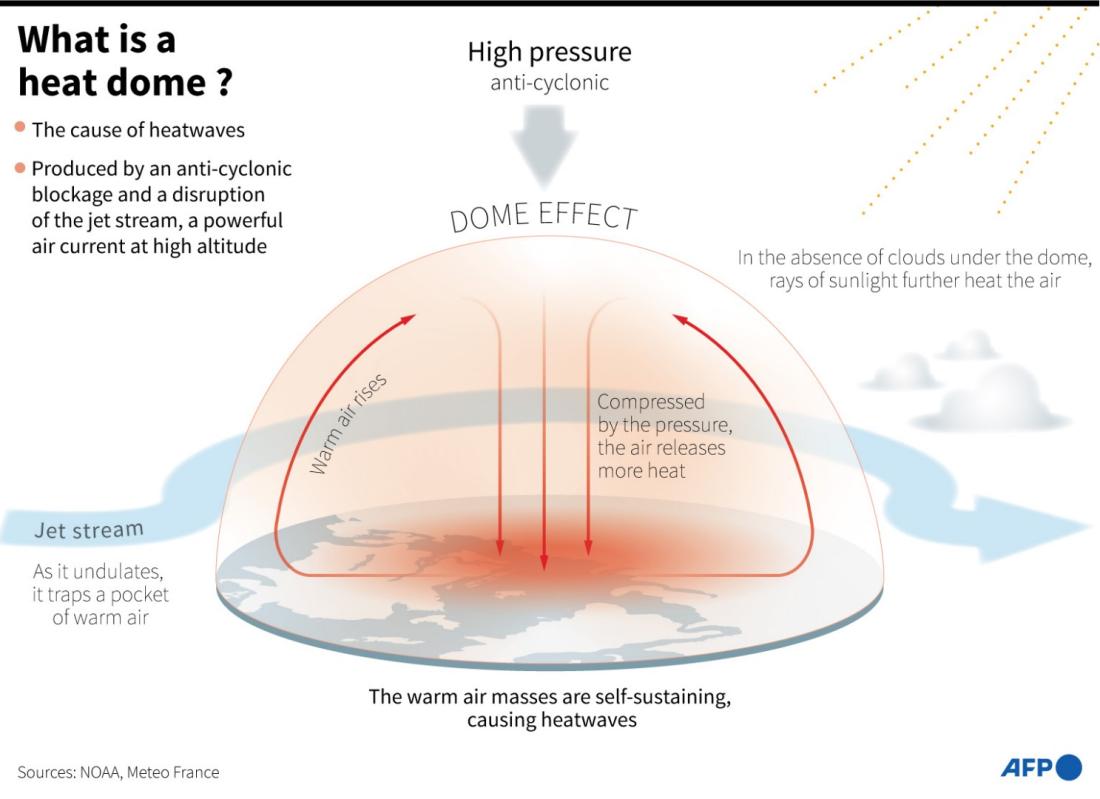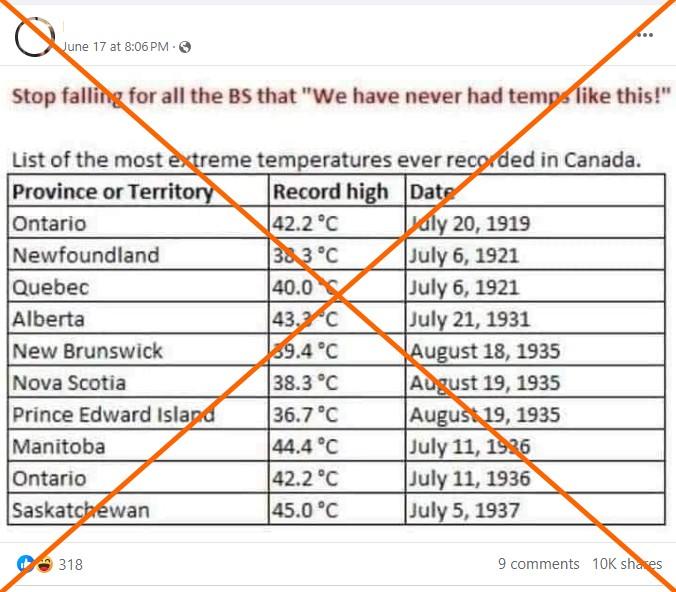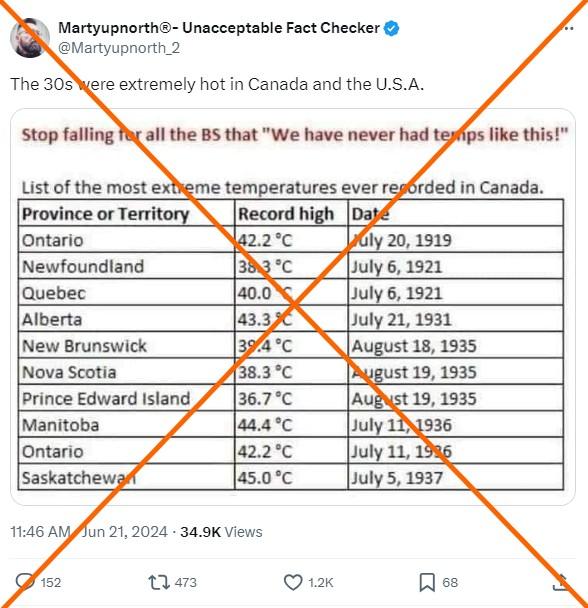
Canadian extreme temperatures table omits recent records
- Published on July 8, 2024 at 14:35
- 6 min read
- By Gwen ROLEY, AFP Canada
Copyright © AFP 2017-2024. Any commercial use of this content requires a subscription. Click here to find out more.
"Stop falling for all the BS that 'We have never had temps like this!'" the text inside a June 17, 2024 Facebook photo says. The image, shared more than 10,000 times, includes a table that purportedly lists "the most extreme temperatures ever recorded" for various Canadian jurisdictions ranging between 36 and 45 Celsius (96.8 and 113 Fahrenheit) all appearing to be measured between 1919 and 1937.
ImageScreenshot of an X post taken July 8, 2024Screenshot of a Facebook post taken July 8, 2024
One of the categories of the table is titled "Province or Territory," but four Canadian jurisdictions are missing from the social media posts: Nunavut, Yukon, the Northwest Territories and British Columbia.
Simon Donner, a professor and climate scientist at the University of British Columbia (archived here), said these omissions are significant because they ignore all the provincial and territorial temperature records measured in the 21st century, including the all-time Canadian extreme of 49.6C (121.2F) set in Lytton, British Columbia on June 29, 2021.
"It's just cherry picking of data that is not actually the most extreme temperatures recorded in Canada," Donner said on July 3, 2024.
2021 heat dome
In June 2021, North America experienced a stagnating bubble of hot air which set temperature records across the western US and Canada. Donner said the omission of British Columbia not only excluded the national record set in Lytton but also ignored the other instances of extreme heat in the province that summer.
"It leaves out the heatwave in 2021 that killed hundreds of Canadians," he said.
Local reporting said health authorities estimate around 600 people died in Canada as a result of the extreme temperatures that June. The day after the national heat record was set in Lytton, the British Columbia village was almost entirely destroyed by a nearby wildfire.
While the misleading social media posts claimed warnings about recent extremes are overreactions, researchers are predicting that heat domes such as the one experienced in 2021 will become more intense because of human-caused climate change (archived here).
There is a near-universal consensus that the burning of fossil fuels is causing global average temperatures to rise (archived here). Donner said that historically cooler regions are warming faster than other parts of the world and the lack of contrast between temperatures slows the movement of weather patterns, allowing heat domes to settle and intensify over a longer period (archived here).

"We are seeing more of these blocking events and more sluggish movement of air in the upper atmosphere," Donner said. "And that follows from what you would expect due to adding greenhouse gases to the atmosphere."
During a June 2024 heat dome seen over the east coast of North America, AFP debunked separate claims that forecasts about extreme temperatures were being exaggerated.
What's in the data?
Environment and Climate Change Canada (ECCC) maintains climate measurements going back to the 19th century in the country and shared its highest provincial and territorial temperature records with AFP on July 2.
According to ECCC data, two more records were set in the 21st century which the social media graphic leaves out: 36.5C (97.7F) in Yukon in 2004 and 39.9C (103.82F) in the Northwest Territories, also during the June 2021 heat dome (archived here and here). The ECCC said its highest recorded temperature for Nunavut was 34.9 C (94.82 F) in 1989, before the region separated from the Northwest Territories (archived here and here).
Beyond the province and territories left out of the graphic on social media, ECCC data measured higher and later records than those claimed in the posts for Alberta, Ontario and Quebec (archived here, here and here).

For Newfoundland and Labrador, ECCC provided a tied record at 37.8C (100.4F), measured twice in 1944 and 1953 (archived here and here). While a reading in that province at 38.3 C (100.9 F) on July 6, 1921 as seen in the social media posts does exist in the government agency's historical data (archived here), ECCC spokeswoman Hannah Boonstra said it was not included in its list of provincial and territorial records because the measurement needed to be validated.
"It is possible the value will be deemed valid; however, it was excluded from the provided table until its validity can be confirmed at a future date," Boonstra said.
The ECCC says online that some historical readings can be erroneous and Boonstra explained daily maximum temperature values are compared with hourly temperatures and measurements from surrounding stations to assess whether a value is suspect (archived here).
Canada warming up faster
A 2019 study from the Government of Canada reported the country is warming at twice the rate as the rest of the world (archived here). Travis Moore, a researcher in climate and atmospheric science and extreme weather at Concordia University (archived here), also said that Canada's highest annual average temperatures were recorded during the last two decades (archived here).
Moore said that as temperatures rise, cooler regions will feel the effects more quickly, and that the social media posts' omissions of far-north Canadian territories was striking to him.
"The North has some very, very impressive records, too," he said.
The Arctic regions of Canada are warming even faster than the rest of the country. A 2022 Finnish study (archived here) found that melting sea ice is providing less surface area to reflect solar radiation and northern regions are absorbing more heat, creating a positive warming feedback loop.
Moore underlined that even as Canada and the North are warming more quickly, all of these rates are being calculated from global averages -- with 2023 being the hottest year on record.
Read more of AFP's reporting on misinformation around climate change and the environment here.


No comments:
Post a Comment